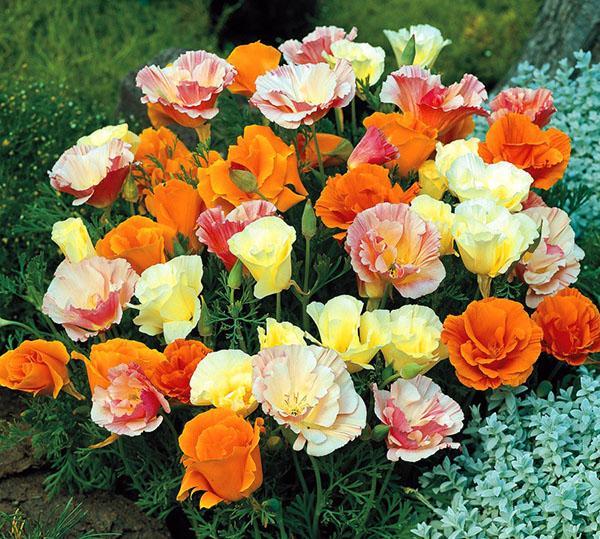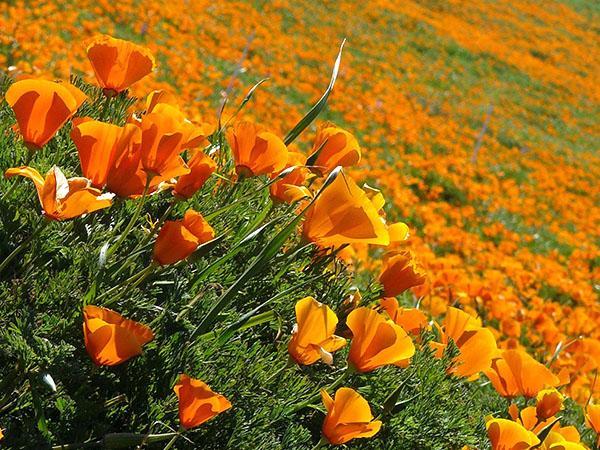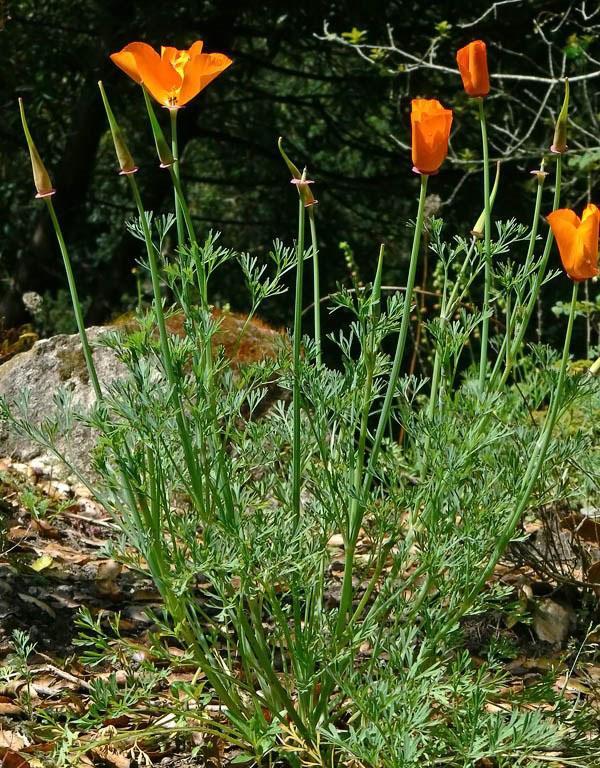Amazing beauty of the garden - Californian escholzia
 From June until the onset of autumn, you can see spectacular golden flowers in the flower beds, strongly resembling miniature poppies. This is Californian escholzia, found more than two hundred years ago in the south of the North American continent and since then has become one of the favorite plants of flower growers all over the world.
From June until the onset of autumn, you can see spectacular golden flowers in the flower beds, strongly resembling miniature poppies. This is Californian escholzia, found more than two hundred years ago in the south of the North American continent and since then has become one of the favorite plants of flower growers all over the world.

Of course, this is nothing more than a beautiful legend, but in a number of regions of the United States the flower is legally protected, and in California it has been considered a living symbol of the state for more than a century.
What does the plant look like? Is there any real benefit or harm from escholzia, and how to grow a flower on your own site?
Californian Eschscholzia (Eschscholzia californica) and its description
 In nature, the plant can be found not only in California, but also in Oregon, Nevada, Arizona, in other states in the south and southwestern United States, as well as in Mexico. Due to the warm climate in their homeland, California poppies are herbaceous perennials, very unpretentious and forming vast fields, completely covered with golden-orange flowers.
In nature, the plant can be found not only in California, but also in Oregon, Nevada, Arizona, in other states in the south and southwestern United States, as well as in Mexico. Due to the warm climate in their homeland, California poppies are herbaceous perennials, very unpretentious and forming vast fields, completely covered with golden-orange flowers.
The plant, from 20 to 50 cm high, forms a branching aerial part with erect stems and dissected leaves of a light green or gray shade sitting on long petioles. In the conditions of central Russia, the cultivation of Californian escholzia is possible in the open field or at home, as a pot culture. On flowerbed - This is a spectacular annual that does not require special care and blooms throughout the warm season.
On the windowsill, subject to autumn-winter illumination, the plant will successfully overwinter, and then it will bloom from the very beginning of spring.
 Flowers of wild-growing Escholzia have a simple, bowl-like shape. The petals are colored yellow, orange, less often red. The variety of varietal plants is much wider. Today, flower growers have varieties with white, purple, pink and even variegated flowers at their disposal. Terry forms of the Californian escholzia are incredibly popular.
Flowers of wild-growing Escholzia have a simple, bowl-like shape. The petals are colored yellow, orange, less often red. The variety of varietal plants is much wider. Today, flower growers have varieties with white, purple, pink and even variegated flowers at their disposal. Terry forms of the Californian escholzia are incredibly popular.
The corolla with a diameter of 5 to 7 cm is sensitive to changes in the weather and time of day; it closes at night and when there is a threat of rain. At the same time, the flower lasts no longer than 2-3 days, but the short-term flowering is compensated by its massiveness. In place of the faded corolla, a seed capsule appears, which, when ripe, opens easily, which leads to frequent self-seeding.
Features of growing escholzia
 The famous Californian fields, completely overgrown with golden flowers, are the result of the high adaptability and incredible unpretentiousness of the escholzia.
The famous Californian fields, completely overgrown with golden flowers, are the result of the high adaptability and incredible unpretentiousness of the escholzia.
The plant does not need any particularly nutritious soil or a special irrigation regime.
Sun-loving flower:
- tolerates drought;
- not afraid of short-term cold snaps;
- can grow in poor soils;
- suitable for landscaping balconies, indoor cultivation.
These qualities of the culture, as well as the long, abundant flowering, influenced the distribution of Californian poppies throughout the world. Eshcholzia cultivation is available in most regions of Russia.
How to sow escholzia
 The plant reproduces by sowing small seeds that easily germinate in the soil, and when stored, retain their germination for two years. How to sow Eschsholzia outdoors?
The plant reproduces by sowing small seeds that easily germinate in the soil, and when stored, retain their germination for two years. How to sow Eschsholzia outdoors?
A well-lit area with light moisture-permeable soil of neutral or slightly acidic reaction is perfect for a culture. Since the seeds are small, they are mixed with dry sand before embedding in the soil. This will simplify the work and guarantee an even germination. Sowing is carried out on the surface of slightly compacted soil, after which the site is carefully watered so as to prevent moisture stagnation.
 The sprouts appear in 1.5–2 weeks. When the first true leaves are formed in young Echscholzia, the plants can be thinned out, leaving one for every 20-25 cm.
The sprouts appear in 1.5–2 weeks. When the first true leaves are formed in young Echscholzia, the plants can be thinned out, leaving one for every 20-25 cm.
Sowing time in open ground
 When to plant Escholzia outdoors? You can sow small seeds of this interesting flower:
When to plant Escholzia outdoors? You can sow small seeds of this interesting flower:
- in spring, starting in mid-April, when the ground warms up enough;
- in autumn, before the onset of persistent frost.
With spring sowing in open ground, flowering often begins only by mid-summer.
In order for Californian poppies to open their corollas already in the first days of summer, experienced flower growers advise to carry out pre-winter sowing or use the seedling method.
Californian escholzia through seedlings
 When to plant Escholzia seedlings? This can be done in the second half of March or in April in such a way that the mature plant will find its permanent place as soon as possible. If you delay, escholzia forms a long taproot that can be easily damaged during transfer to the flower bed. alpine slide or a discount.
When to plant Escholzia seedlings? This can be done in the second half of March or in April in such a way that the mature plant will find its permanent place as soon as possible. If you delay, escholzia forms a long taproot that can be easily damaged during transfer to the flower bed. alpine slide or a discount.
When preparing the soil for sowing or planting Escholzia seedlings, you should not use fresh organic matter, and also be zealous with watering the growing flowers.
Growing escholzia in a pot
 To green a balcony, terrace or decorate a window sill in a room, flower growers choose not only beautiful, but also the most hardy plants. Eschsholzia is excellent for these purposes. She is not afraid of direct sunlight, lack of moisture and nutrients.
To green a balcony, terrace or decorate a window sill in a room, flower growers choose not only beautiful, but also the most hardy plants. Eschsholzia is excellent for these purposes. She is not afraid of direct sunlight, lack of moisture and nutrients.
At home, growing Echscholzia from seeds will not be difficult even for a beginner. It is convenient to sow seeds directly into a balcony flower box or pot. The soil should be light, loose and sufficiently water-absorbing. This soil is obtained by mixing garden soil, low-lying peat, sand or perlite.
 With minimal care, escholzia actively grows and bushes, willingly blooms even in the cold season. True, for this the grower will have to take care of artificially extending daylight hours to 12-14 hours. The rest of the care is:
With minimal care, escholzia actively grows and bushes, willingly blooms even in the cold season. True, for this the grower will have to take care of artificially extending daylight hours to 12-14 hours. The rest of the care is:
- moderate watering when the surface layer of the soil dries up;
- removal of wilted corollas;
- half dose of flowering plant food.
Even before planting escholzia in pots, it must be borne in mind that the flower branches and has long roots. For most Californian poppy varieties, a container with a depth and width of at least 18-20 cm is suitable.
The medicinal properties of Californian escholzia
 Flower growers are attracted by the simple planting and care of escholzia in the open field, bright long flowering and many spectacular varieties. However, these are not all the advantages of the plant.
Flower growers are attracted by the simple planting and care of escholzia in the open field, bright long flowering and many spectacular varieties. However, these are not all the advantages of the plant.
In landscape design, escholzia is used on alpine slides, in mixborders with other annuals, to form moorish lawn and in traditional flower beds.
Escholzia, a member of the Poppy family, has traditionally been used by American Indians as a pain reliever and sedative. Modern research on the medicinal properties of Californian escholzia has fully confirmed the folk experience.
All parts of the plant have biological activity. Raw materials containing such alkaloids as helirubin, sanguinarine and macarine, flavone glycosides and other valuable substances are collected at the time of flowering, dried or used fresh.
 For medicinal purposes, extracts, alcoholic tinctures and powders are prepared from Californian poppies, which have a calming, analgesic and antispasmodic effect.
For medicinal purposes, extracts, alcoholic tinctures and powders are prepared from Californian poppies, which have a calming, analgesic and antispasmodic effect.
The most common indication for use is:
- insomnia;
- anxiety and nervous tension;
- toothache and spasmodic pain;
- urinary incontinence.
For the older age group, Escholzia preparations will be useful for the prevention of memory disorders and improvement of the intellectual state in general.
Drinking California poppy tincture or powder can cause unwanted body reactions. Therefore, before taking you need a consultation with your doctor.
The sap of the plant has analgesic properties. To relieve pain in the event of damage or inflammation of the gums, a fresh root of Californian Escholzia is cut lengthwise and applied to the affected area. Due to its antimicrobial properties, the product facilitates and accelerates treatment:
- abrasions;
- scratches;
- irritation;
- inflammatory processes on the skin and mucous membranes.
 Antispasmodic qualities help relieve:
Antispasmodic qualities help relieve:
- muscle pain and spasms;
- nervous tension after a hard day;
- an attack of a harsh cough.
At high body temperature, a decoction or infusion of escholzia will play the role of a natural antihistamine. Tincture from the root of the plant is used to treat the mammary glands to suppress lactation in women who are breastfeeding. And powder is the basis of the folk way to get rid of head lice.
Preparation and dosage of escholzia infusion
 An aqueous infusion can be prepared using 2 grams of dried herb and 150 ml of water. Vegetable raw materials are poured with boiling water, brought to a boil and left to infuse. The finished composition is filtered and drunk 2-3 times a day at:
An aqueous infusion can be prepared using 2 grams of dried herb and 150 ml of water. Vegetable raw materials are poured with boiling water, brought to a boil and left to infuse. The finished composition is filtered and drunk 2-3 times a day at:
- insomnia;
- irritability;
- anxiety and other mild disorders.
If your medicine cabinet contains an extract or alcoholic tincture of California poppy:
- with mild pain and anxiety, drink 15 to 25 drops three times a day;
- in severe cases, the dose is increased to 30-40 drops and consumed 2-5 times a day.
Unlike poppy, which requires extra careful handling, the plant does not contain opiates.
Therefore, with a mass of useful properties, there are much fewer contraindications for escholzia.
Precautions for taking Californian escholcea
If you adhere to the recommendations of a specialist and the prescribed dosages, the plant is considered safe for children and adults. It can be grown without restrictions in the garden and at home.
Californian poppy products are not recommended for women who are pregnant or breastfeeding.
Escholzia varieties for open ground and home
 Unpretentious eschsholzia delight with lush flowering all summer. In this case, seed pods are formed in place of withering flowers. If they are not collected in time, self-seeding occurs. And next year the plants will appear outside the flower bed. Unfortunately, such specimens often do not retain the characteristics inherent in the parent varieties.
Unpretentious eschsholzia delight with lush flowering all summer. In this case, seed pods are formed in place of withering flowers. If they are not collected in time, self-seeding occurs. And next year the plants will appear outside the flower bed. Unfortunately, such specimens often do not retain the characteristics inherent in the parent varieties.
 Therefore, growers familiar with the culture advise using only varietal seeds. In this case, the flower bed with escholzia before frost will be covered with delicate flowers of orange, white, yellow, purple and pink shades.
Therefore, growers familiar with the culture advise using only varietal seeds. In this case, the flower bed with escholzia before frost will be covered with delicate flowers of orange, white, yellow, purple and pink shades.
The dark red rims of the Mikado escholzia, dotted with orange strokes, look very impressive. Flowers of a simple shape captivate with a silky sheen and rich color, which practically does not fade in the hot summer sun.
Terry flowers of the Orange King variety or the Escholzia Cup of Peace look even more expressive. Both plants reach a height of 50 cm, and the corollas in the stage of complete dissolution open 10 cm.
 Varieties with colors unusual for wild-growing will help to diversify the flower garden and add new colors to it. Among these varieties:
Varieties with colors unusual for wild-growing will help to diversify the flower garden and add new colors to it. Among these varieties:
- the eschsholzia shown in the photo Lilac ray with simple flowers of lilac or pinkish color;
- escholzia Apple flower with double flowers combining white, yellowish, crane and carmine pink tones.
The diameter of the corollas is 7 cm, and the plants rise 35–40 cm above the flower bed.
Interesting about eschsholzia - video
Good day. Help determine the name of the flower?
You have a charming torenia blooming - by its nature a garden annual (in our area it does not hibernate in the open ground, since the flower is native to the African tropics). But toria can successfully live for several years as an indoor flower. Your variety is called Fournier Torenia, a compact bush, usually does not grow taller than 25 cm. The plant prefers partial shade and warmth. In winter, the temperature should not be allowed to drop below 15 degrees Celsius, otherwise the bush will die. Watering - as the soil dries out, excess moisture is harmful. Twice a month you can feed with a mineral complex for flowering (when watering).